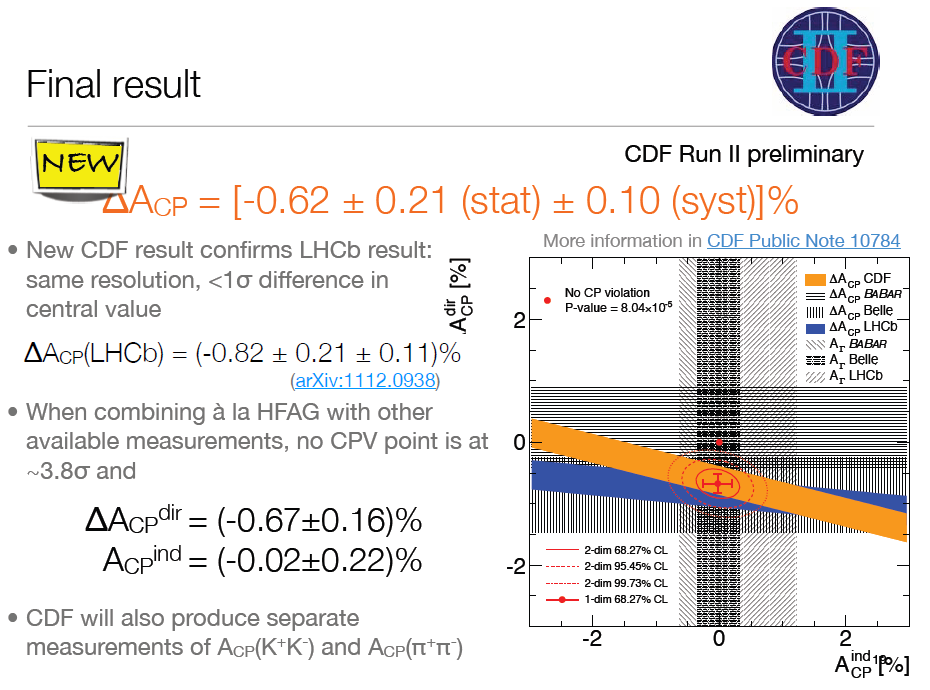Back in November, I described a surprising result from the LHCb experiment at the Large Hadron Collider [LHC] concerning “CP violation” in the decays of particles called “D mesons” (which are hadrons that contain an unpaired charm quark or an unpaired charm antiquark) at a level much larger than expected by theorists. Rather than rehashing the explanation for what that was all about, I’m going to point you to what I wrote in November.
There’s news this week that the CDF experiment at the now-closed Tevatron has updated its result for a measurement of the same quantity, using the full CDF data set. And they now find a very similar result to what LHCb found. This is indicated on the slide shown below, taken from the talk given by Angelo Di Canto at the La Thuile conference (but edited by me to fix a big typo; I hope he does not mind.) You see that while LHCb found a CP-violating asymmetry of -0.82%, with statistical and systematic uncertainties of 0.21% and 0.11%, CDF finds -0.62%, with almost identical uncertainties — a little closer to zero, but still well away from it.

This lends support to LHCb’s result, and putting the two results (and a couple of other weaker ones) together makes their combination discrepant from zero by about 3.8 standard deviations. That’s great, but not as great as it would have been if what theorists thought a few years ago was still considered reliable. Back then, the relevant experts (and I should emphasize I am not one of them) would have told you that they were pretty darn certain that the Standard Model [the equations we use to describe the known particles and forces] could not produce CP violation of this type, and any observation of a non-zero signal would imply the existence of previously unknown particles. But the experts have been backing away from this point of view recently, worrying that maybe they know less about how to calculate this in the Standard Model than they used to think. If we’re to be sure this is really a sign of new particles in nature, and not just a sign that theorists have trouble predicting this quantity, we’re going to need additional evidence from another quarter. And so far, we haven’t got any.




11 Responses
I am not sure how to read this — surely `how to do’ a calculation in the standard model is well understood?
Let ,me rephrase that — which sort of calculations (I guess those involving quarks are the suspect ones) are not understood?
I hope this question has an answer a layman can understand. I’d guess it’s contributions that have been known to be difficult to calculate but previously believed to be very small.
We might know what the formula is, but the calculations are extremely difficult. Think multi-dimension PDEs. My understanding (I’m not a physicist) is that there are heuristics that can simplify things, but it’s not always clear that the heuristics are correct.
CP stands for Charge-Parity, right?
If weak interaction does violate weak charge conservation (It is called weak isospin, am I right?), then such violations could also happen in eletric and chromo charge too?
Thanks for your time, Matt.
So if this is evidence of new particles what particles would they be and what would be their properties?
Matt: “Back then, the relevant experts (and I should emphasize I am not one of them) would have told you that they were pretty darn certain that the Standard Model [the equations we use to describe the known particles and forces] could not produce CP violation of this type, and any observation of a non-zero signal would imply the existence of previously unknown particles. But the experts have been backing away from this point of view recently, worrying that maybe they know less about how to calculate this in the Standard Model than they used to think. If we’re to be sure this is really a sign of new particles in nature, and not just a sign that theorists have trouble predicting this quantity, we’re going to need additional evidence from another quarter. And so far, we haven’t got any.”
Among all blog reports on this LHCb result, the above passage is the only one having the relevancy to the importance of this result. Thanks Matt.
Thanks for your message. This rellay doesn’t matter much; the Higgs search will proceed in the same way whether of not 140 GeV is or is not yet ruled out. And it will be ruled out clearly (if the Higgs is not there) within a few months. Calling SUSY dead prematurely is more serious, because it might affect search strategies and the way the LHC is operated, and might in the long run affect public perception of the LHC. But there are enough people in the experiments (Moortgat is an example) who know this that I am currently not too worried about the next round of searches; the holes that we (Lisanti, Schuster, Toro and I) emphasized recently will be filled, along with a number of others.The next challenge is to dig deeper into the data. I doubt most people realize how easy [relatively!! nothing is easy at LHC] most searches have been so far, compared to what may be necessary for finding new phenomena.